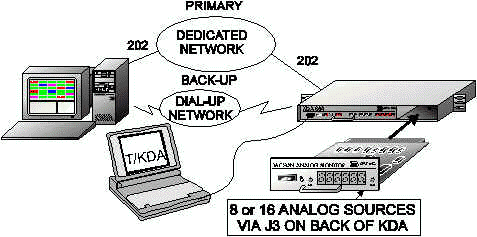Check out our White Paper Series!
A complete library of helpful advice and survival guides for every aspect of system monitoring and control.
1-800-693-0351
Have a specific question? Ask our team of expert engineers and get a specific answer!
Sign up for the next DPS Factory Training!

Whether you're new to our equipment or you've used it for years, DPS factory training is the best way to get more from your monitoring.
Reserve Your Seat Today
Extend the KDA: A KDA remote equipped with the NIA card brings conventional discrete alarm and control points to your existing SNMP management system, using your already deployed 10 Base-T network.
The Network Interface Adapter fits in the expansion card slot of a KDA864 Alarm and Control Remote to interface it directly to an Ethernet 10 Base-T network using SNMP protocol.
A KDA remote equipped with the NIA card brings conventional discrete alarm and control points to your existing SNMP management system, using your already deployed 10 Base-T network.
The KDA remote is able to deal with the multitude of monitoring requirements at remote telecom sites... environmental status, battery plant voltages, security, switch alarms, transmission equipment, tower lights, outside plant status - be it a small hut or an entire central office.
The KDA with NIA card brings flexibility and intelligence to your Network Management System. Flexible to handle today's needs and intelligent enough to fulfill future demands. T/KDA software includes a protocol analyzer.
Flexible
The NIA card can be mounted in the expansion card slot of the KDA host or it can be located in its own housing near the KDA host.
The KDA's alarm inputs are optically isolated, polarity reversible. Control outputs are relay isolated. Magnetic-latching relays are optional.
The host KDA must be equipped with an RS232 docking pad on the primary port in order to interface the NIA card's collection port. The NIA card communicates with the network using an 802.3 10-BaseT Ethernet transport. An alternate path routing function can be accommodated via a dialup port on the NIA card, using Ethernet SLIP/PPP.
Front panel LEDs show unit activity and alarm conditions. A visual fuse alarm indicator is included.
The host KDA with NIA card features plug-in P.C. boards in a fixed-mount housing with a connectorized backplane.
Intelligent
Personnel can use T/KDA software on a personal computer at the front panel craft port for local configuration or full interactive monitoring. The software includes the MIB (Management Information Base) and TDF (Trap Definition File). T/KDA software includes a protocol analyzer.


Voltage Source
Plant battery and AGC voltage fluctuations are two examples of voltage sources that may be monitored by the analog card. In addition to the threshold alarms generated, the analog card provides real-time absolute voltage measurements, both to the alarm master and at the front panel display.
Current Source
Many temperature, pressure and other transducers use a current loop principle. Current flow in the loop changes as the measured value changes. The analog card reads these current changes as a voltage across a 250 ohm shunt resistor on the input. The front panel display shows voltage, but the T/MonXM master or the T/KDA screen can show values in native units.
Analog Scaling and Offset
The Analog Card can make a measured input voltage smaller or larger (called scaling), shift its value range (called offset) and assign a units suffix (volts, degrees, PSI, etc.).
| Specifications | |
|---|---|
| Analog Inputs: | 16 |
| Conversion Bits: | 12 bit ADC's |
| Input Voltage Scales: | -79.9 VDC to +79.9 VDC |
| Voltage Resolution: |
|
| Power Input: |
|
| Analog Accuracy: | +/- 1.5% |
| Fuse: | 1/4 Amp |
| Operating Range: | 0 to +60 Degrees Celsius. Option X5 -30 to +70 Degrees C |
| Humidity: | 0% to 95% non-condensing |
| Description | Model Number |
|---|---|
| Network Interface Adapter | D-PC-770-10A-0V |
| "V" Option Numbers | Power Supply Voltage (V): 0 = Wide Range (-18 to -72 VDC), 2 = -24 VDC, 4 = -48 VDC, |